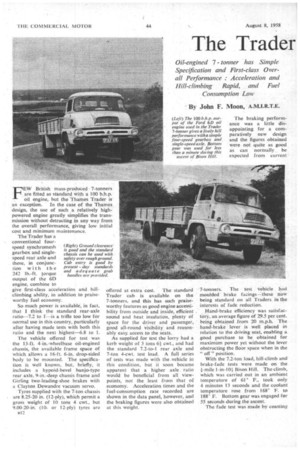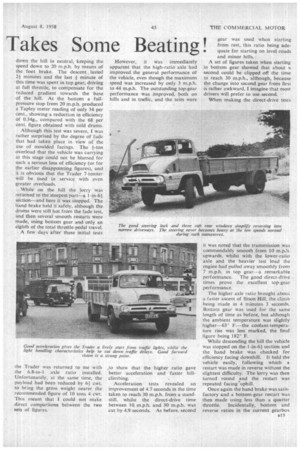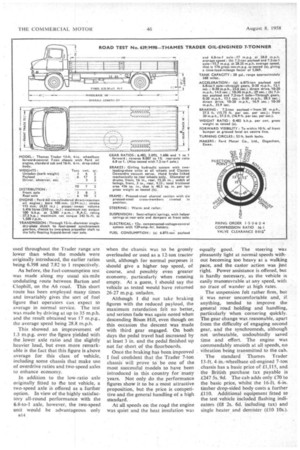The Trader Takes Some Beating
Page 46

Page 47

Page 48

If you've noticed an error in this article please click here to report it so we can fix it.
Oil-engined 7 tonner has Simple Specification and First-class Overall Performance : Acceleration and Hill-climbing Rapid, and Fuel Consumption Low
By John F. Moon, A.M.I.R.T.E.
FEW British mass-produced • 7-tanners are fitted as standard with a 100 b.h.p. oil engine, but the Thames Trader is an exception. In the case of the Tharties.
design, the use of such a relatively highpowered engine greatly simplifies the trans mission without detracting in any way from the overall performance, giving low initial cost and minimum maintenance.
The Trader has a conventional fourspeed synchromesh gearbox and singlespeed rear axle and these, in conjunction with the 242 lb.-ft. torque output of the 6D engine, combine to give first-class acceleration and hillclimbing ability, in addition to praiseworthy fuel economy.
So much power is available, in fact, that I think the standard rear-axle ratio-7.2 to 1—is a trifle too low for normal use in this country, particularly after having made tests with both this ratio and the next highest-6.8 to 1.
The vehicle offered for test was the 13-ft. 4-in.-wheelbase oil-enginect chassis, the available frame space of which allows a 16-ft. 6-in. drop-sided body to be mounted. The specification is well known, but, briefly, it includes a hypoid-bevel banjo-type rear axle, 9-in.-deep chassis frame and Girling two-leading-shoe brakes with a Clayton Dewandre vacuum servo.
Tyres supplied with the 7-ton chassis are 8.25-20 in. (12-ply), which permit a gross weight of 10 tons 4 cwt., but 9.00-20-in. (10or 12-ply) tyres are (Right) Ground clearance is good and the standard chassis can be used with safety over rough ground. Cab entry is good by present day standards and adequate grab handles are provided.
offered at extra cost. The standard Trader cab is available on the 7-tonners, and this has such praiseworthy features as good engine accessibility from outside and inside, efficient sound and heat insulation, plenty of space for the driver and passenger, good all-round visibility and reasonably easy access to the seats.
As supplied for test the lorry had a kerb weight of 3 tons 61 cwt., and had the standard 7.2-to-1 rear axle and 7-ton 4-cwt, test load, A full series of tests was made with the ,vehicle in this condition, but it soon became apparent that a higher axle ratio would be beneficial from all viewpoints, not the least from that of economy. Acceleration times and the fuel-consumption rate recorded are shown in the data panel, however, and the braking figures were also obtained at this weight. 7-tonners. The test vehicle had moulded brake facings—these now being standard on all Traders in the interests of fade reduction.
The braking performance was a little disappointing for a comparatively new design and the figures obtained were not quite as good as can normally, be expected from current
Hand-brake efficiency was satisfactory, an. average figure of 29.5 per cent. being obtained from 20 m.p.h. The hand-brake lever is well placed in relation to the driving seat, enabling a good purchase to be obtained for maximtm power yet without the lever obstructing the floor space when in the " off " position.
With the 7.2-ton load, hill-climb and brake-fade tests were made on the 1-in-101 Bison Hill. The climb, which was carried out in an ambient temperature of 61° F., took only 4 minutes 13 seconds and the coolant temperature rose from 168° F. to 188° F. Bottom gear was engaged for 55 seconds during the ascent.
The fade test was made by coasting
down the hill in neutral, keeping the speed down to 20 m.p.h. by means of the foot brake. The descent lasted 24 minutes and the last minute of this time was spent in top gear, driving at full throttle, to compensate for the reduced gradient towards the base of the hill. At the bottom a fullpressure stop from 20 m.p.h. produced a Tapley meter reading of only 34 per cent., showing a reduction in efficiency of 0.34g., compared with the 68 per cent. figure obtained with cold drums.
Although this test was severe, I was rather surprised by the degree of fade that had taken place in view of the use of moulded facings. The 4-ton overload that the vehicle was carrying at this stage could not be blamed for such a serious loss of efficiency (or for the earlier disappointing figures), and it is obvious that the Trader 7-tonner will be used in service with even greater overloads.
While on the hill the lorry was returned to the steepest part—a I -in-64 section—and here it was stopped. The hand brake held it safely, although the drums were-still hot from the fade test, and then several smooth restarts were made, using bottom gear and only an eighth of the total throttle-pedal travel.
A few days after these initial tests
the Trader was returned to me with the 6.8-to-I axle ratio installed. Unfortunately, at the same time, the payload had been reduced by 61 cwt. to bring the gross weight nearer the recommended figure of 10 tons 4 cwt. This meant that I could not make direct comparisons between the two sets of figures.
However, it was immediately apparent that the high-ratio axle had improved the general performance of the vehicle, even though the maximum speed was increased by only 3 m.p.h. to 44 m.p.h. The outstanding top-gear performance was .improved, both on hills and in traffic, and the tests were ,to show that the higher ratio gave better acceleration and faster hillclimbing.
Acceleration tests revealed an improvement of 4.7 seconds in the time taken to reach 30 rn.p.h. from a standstill, whilst the direct-drive time between JO. m.p.h. and 30 m.p.h. was cut by 4.9 seconds. As before, second
gear was used when starting from rest, this ratio being adc • pate for starting on level roads and minor hills.
A set of figures taken when starting in bottom gear showed that about a second could be clipped off the time to reach 30 m.p.h., although, because the change into second gear from first is rather awkward. I imagine that most drivers will prefer to use second.
When making the direct-drive tests it was noted that the transmission was commendably smooth from 10 m.p.h. upwards, whilst with the lower-ratio axle and the heavier test load the engine had pulled away smoothly from 7 m.p.h. in top gear—a remarkable performance. The good direct-drive times prove the excellent top-gear performance.
The higher axle ratio brought about a faster ascent of Bison Hill, the climb being made in 4 minutes 3 seconds. Bottom gear was used for the same length of time as before, but although the ambient temperature was slightly higher-63 F.—the coolant-temperature rise was less marked, the final figure being 182° F.
While descending the hill the vehicle was stopped on the 1-in-64 section and the hand brake was checked for efficiency facing downhill. It held the vehicle easily, following which a restart was made in reverse without the slightest difficulty. The lorry was then turned round and the restart was repeated facing uphill.
Once again the hand brake was satisfactory and a bottom-gear restart was then made using. less than a quarter throttle. Incidentally, bottom and reverse ratios in the current gearbox
used throughout the Trader range are lower than when the models were originally introduced, the earlier ratios being 6.398 and 7.82 to I respectively.
As before, the fuel-consumption test was made along my usual. six-mile undulating route between Barton and Clophill, on the A6 road. This short route has been employed many times and invariably gives the sort of fuel figure that operators can expect to average in normal service. The test was made by driving at up to 35 m.p.h. and the result obtained was 17 m.p.g., the average speed being 28.8 m.p.h.
This showed. an improvement of 1.3 m.p.g. over the figure yielded with the lower axle ratio and the slightly heavier load, but even more remarkable is the fact that this figure is above average for this class of vehicle, including some chassis that make use of overdrive ratios and two-speed axles to enhance economy.
In addition to the low-ratio axle originally fitted to the test vehicle, a two-speed axle is offered as a further option. In view of the highly satisfactory all-round performance with the 6.8-to-1 axle, however, the two-speed unit would be advantageous only RI4 when the chassis was to be grossly overloaded or used as a 12-ton tractor unit, although for normal purposes it should give a higher top speed, of course, and possibly even greater economy. particularly when running empty. At a guess, I should say the vehicle as tested would have returned 26-27 m.p.g. unladen.
Although I did not take braking figures with the reduced payload, the maximum retardation felt no better, and serious fade was again noted when descending Bison Hill, even though on this occasion the descent was made with third gear engaged. On both days the pedal travel had increased by at least 3 in, and the pedal finished up not far short of the floorboards.
Once the braking has been improved I feel confident that the Trader 7-ton chassis will prove to be one of the most successful models to have been introduced in this Country for many years. Not only do the performance figures show it to be a most attractive proposition, but the price is competitive and the general handling of a high standard.
At all speeds on the rod the engine was quiet and the heat insulation was equally good. The steering was pleasantly light at normal speeds without becoming too heavy at a walking pace, and the castor action was just right. Power assistance is offered, but is hardly necessary, as the vehicle is easily manceuvrable at any speed, with no trace of wander at high rates.
The suspension felt rather firm, but it was never uncomfortable and, if. anything, tended to improve the general road holding and handling, particularly when cornering quickly. The gear change was reasonable, apart from the difficulty of engaging second gear, and the synchromesh, although not unbeatable, undoubtedly saved time and effort. The engine was commendably smooth at all speeds, no vibration being transmitted to the cab.
The standard Thames Trader 13-ft. 4-in.-wheelbase oil-engined 7-ton chassis has a basic price of £1,115, and the British purchase tax payable is £247 5s. 9d. The cab adds only £70 to the basic price, whilst the 16-ft. 6-in. timber drop-sided body costs a further £110. Additional equipment fitted to the test vehicle included flashing indicators (£8 2s. 6d. including tax) and single heater and demister (£10 10s.).




































































































